2019 NISSAN KICKS wheel
[x] Cancel search: wheelPage 407 of 444
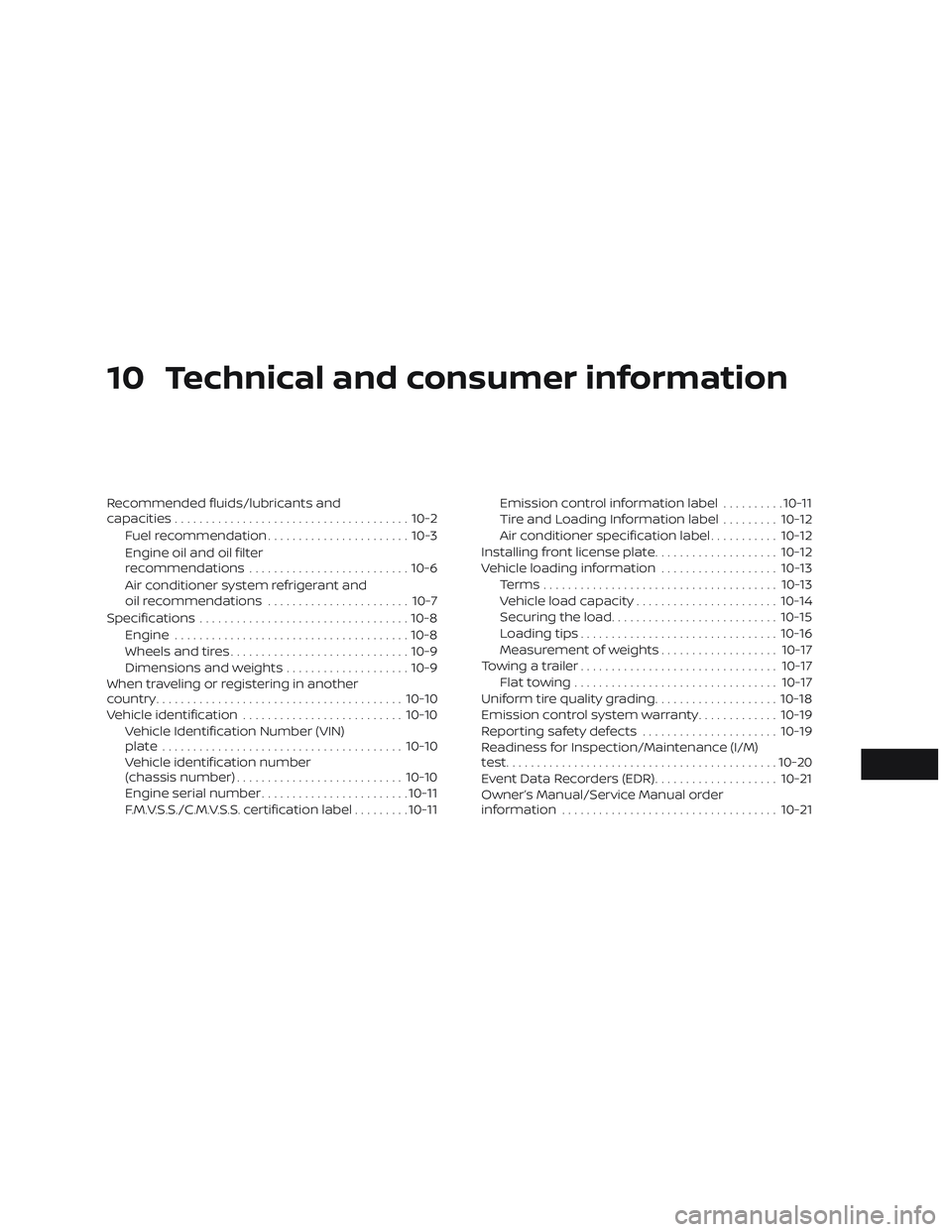
10 Technical and consumer information
Recommended fluids/lubricants and
capacities...................................... 10-2
Fuel recommendation ....................... 10-3
Engine oil and oil filter
recommendations .......................... 10-6
Air conditioner system refrigerant and
oil recommendations ....................... 10-7
Specifications .................................. 10-8
Engine ...................................... 10-8
Wheels and tires ............................. 10-9
Dimensions and weights ....................10-9
When traveling or registering in another
country ........................................ 10-10
Vehicle identification .......................... 10-10
Vehicle Identification Number (VIN)
plate ....................................... 10-10
Vehicle identification number
(chassis number) ........................... 10-10
Engine serial number ........................ 10-11
F.M.V.S.S./C.M.V.S.S. certification label .........10-11 Emission control information label
..........10-11
Tire and Loading Information label .........10-12
Air conditioner specification label ...........10-12
Installing front license plate ....................10-12
Vehicle loading information ...................10-13
Terms ...................................... 10-13
Vehicle load capacity ....................... 10-14
Securing the load ........................... 10-15
Loading tips ................................ 10-16
Measurement of weights ...................10-17
Towing a trailer ................................ 10-17
Flat towing ................................. 10-17
Uniform tire quality grading ....................10-18
Emission control system warranty .............10-19
Reporting safety defects ......................10-19
Readiness for Inspection/Maintenance (I/M)
test ............................................ 10-20
Event Data Recorders (EDR) ....................10-21
Owner’s Manual/Service Manual order
information ................................... 10-21
Page 415 of 444
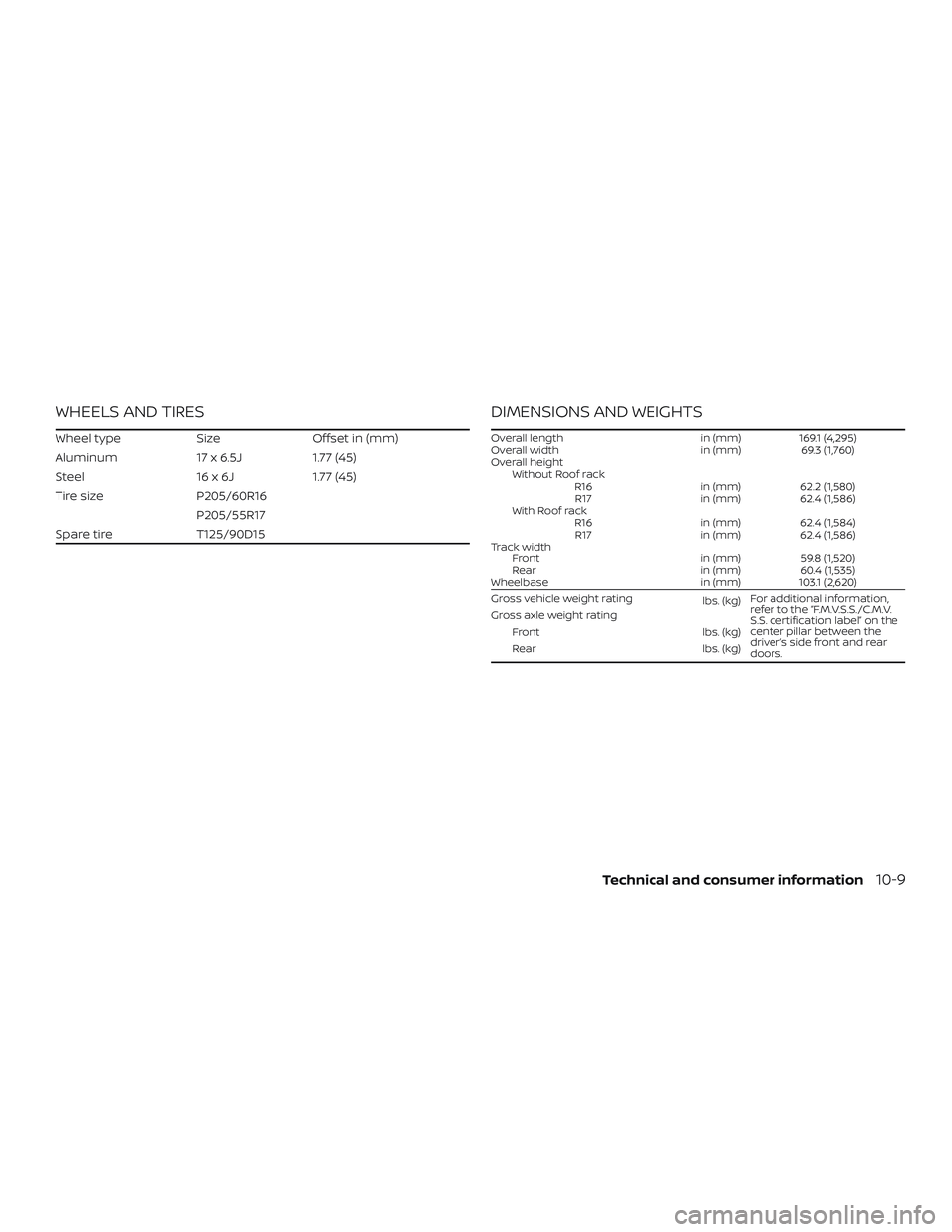
WHEELS AND TIRES
Wheel typeSizeOffset in (mm)
Aluminum 17 x 6.5J1.77 (45)
Steel 16 x 6J1.77 (45)
Tire size P205/60R16
P205/55R17
Spare tire T125/90D15
DIMENSIONS AND WEIGHTS
Overall length in (mm)169.1 (4,295)
Overall width in (mm)69.3 (1,760)
Overall height Without Roof rack R16 in (mm)62.2 (1,580)
R17 in (mm)62.4 (1,586)
With Roof rack R16 in (mm)62.4 (1,584)
R17 in (mm)62.4 (1,586)
Track width Front in (mm)59.8 (1,520)
Rear in (mm)60.4 (1,535)
Wheelbase in (mm)103.1 (2,620)
Gross vehicle weight rating lbs. (kg)For additional information,
refer to the “F.M.V.S.S./C.M.V.
S.S. certification label” on the
center pillar between the
driver’s side front and rear
doors.
Gross axle weight rating
Front lbs. (kg)
Rear lbs. (kg)
Technical and consumer information10-9
Page 423 of 444
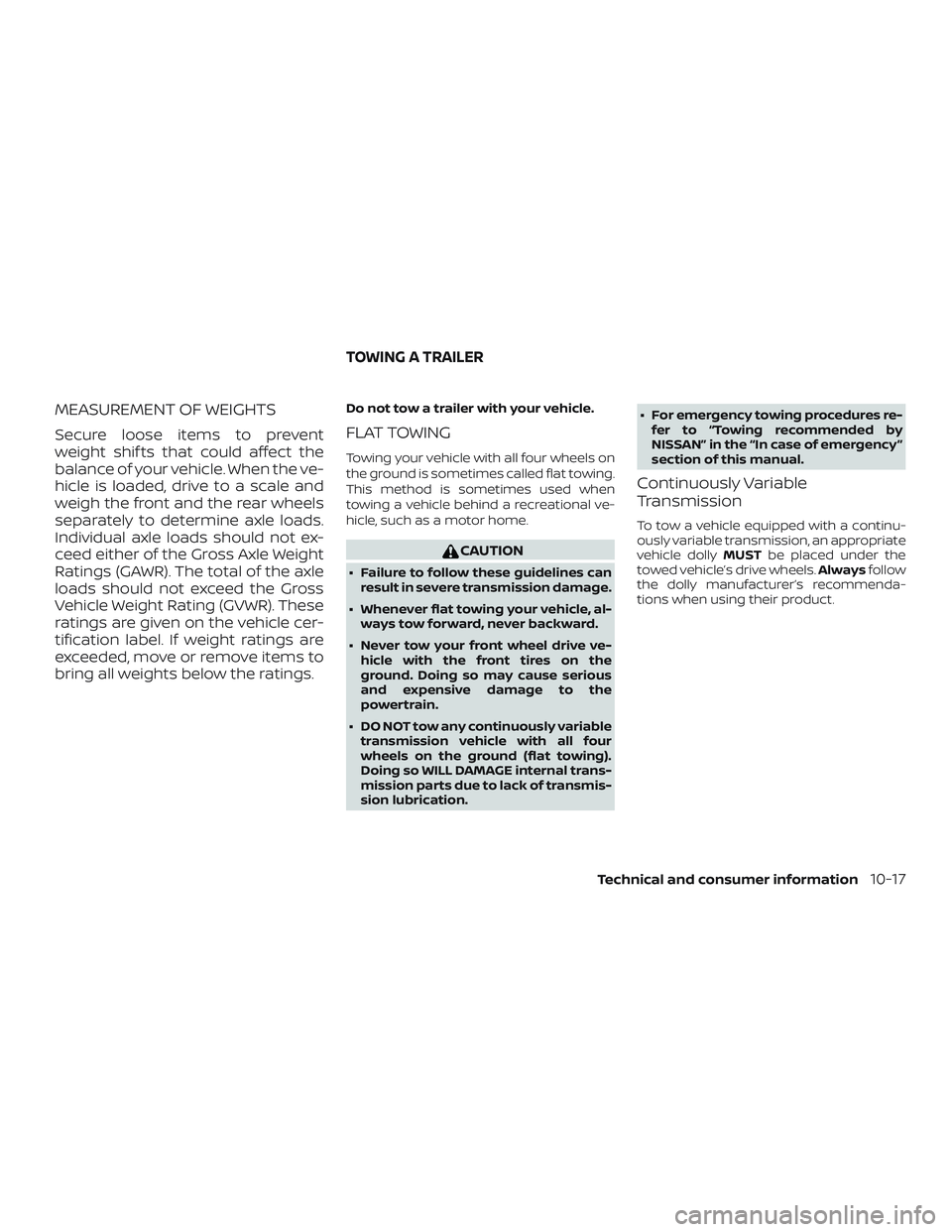
MEASUREMENT OF WEIGHTS
Secure loose items to prevent
weight shif ts that could affect the
balance of your vehicle. When the ve-
hicle is loaded, drive to a scale and
weigh the front and the rear wheels
separately to determine axle loads.
Individual axle loads should not ex-
ceed either of the Gross Axle Weight
Ratings (GAWR). The total of the axle
loads should not exceed the Gross
Vehicle Weight Rating (GVWR). These
ratings are given on the vehicle cer-
tification label. If weight ratings are
exceeded, move or remove items to
bring all weights below the ratings.
Do not tow a trailer with your vehicle.
FLAT TOWING
Towing your vehicle with all four wheels on
the ground is sometimes called flat towing.
This method is sometimes used when
towing a vehicle behind a recreational ve-
hicle, such as a motor home.
CAUTION
∙ Failure to follow these guidelines canresult in severe transmission damage.
∙ Whenever flat towing your vehicle, al- ways tow forward, never backward.
∙ Never tow your front wheel drive ve- hicle with the front tires on the
ground. Doing so may cause serious
and expensive damage to the
powertrain.
∙ DO NOT tow any continuously variable transmission vehicle with all four
wheels on the ground (flat towing).
Doing so WILL DAMAGE internal trans-
mission parts due to lack of transmis-
sion lubrication. ∙ For emergency towing procedures re-
fer to “Towing recommended by
NISSAN” in the “In case of emergency ”
section of this manual.
Continuously Variable
Transmission
To tow a vehicle equipped with a continu-
ously variable transmission, an appropriate
vehicle dolly MUSTbe placed under the
towed vehicle’s drive wheels. Alwaysfollow
the dolly manufacturer’s recommenda-
tions when using their product.
TOWING A TRAILER
Technical and consumer information10-17
Page 424 of 444

DOT (Department of Transportation) Qual-
ity Grades: All passenger car tires must
conform to federal safety requirements in
addition to these grades.
Quality grades can be found where appli-
cable on the tire sidewall between tread
shoulder and maximum section width. For
example:
Treadwear 200 Traction AA Temperature
A
Treadwear
The treadwear grade is a comparative rat-
ing based on the wear rate of the tire when
tested under controlled conditions on a
specified government test course. For ex-
ample, a tire graded 150 would wear one
and one-half (1 1/2) times as well on the
government course as a tire graded 100.
The relative performance of tires depends
upon the actual conditions of their use,
however, and may depart significantly from
the norm due to variations in driving habits,
service practices and differences in road
characteristics and climate.
Traction AA, A, B and C
The traction grades, from highest to low-
est, are AA, A, B, and C. Those grades repre-
sent the tire’s ability to stop on wet pave-ment as measured under controlled
conditions on specified government test
surfaces of asphalt and concrete. A tire
marked C may have poor traction perfor-
mance.
WARNING
The traction grade assigned to this tire
is based on straight-ahead braking
traction tests, and does not include ac-
celeration, cornering, hydroplaning, or
peak traction characteristics.
Temperature A, B and C
The temperature grades are A (the high-
est), B, and C, representing the tire’s resis-
tance to the generation of heat, and its
ability to dissipate heat when tested under
controlled conditions on a specified indoor
laboratory test wheel. Sustained high tem-
perature can cause the material of the tire
to degenerate and reduce tire life, and ex-
cessive temperature can lead to sudden
tire failure. The grade C corresponds to a
level of performance which all passenger
car tires must meet under the Federal Mo-
tor Vehicle Safety Standard No. 109. Grades
B and A represent higher levels of perfor-
mance on the laboratory test wheel than
the minimum required by law.
WARNING
The temperature grade for this tire is
established for a tire that is properly in-
flated and not overloaded. Excessive
speed, under-inflation, or excessive
loading, either separately or in combi-
nation, can cause heat build-up and
possible tire failure.
UNIFORM TIRE QUALITY GRADING
10-18Technical and consumer information
Page 429 of 444
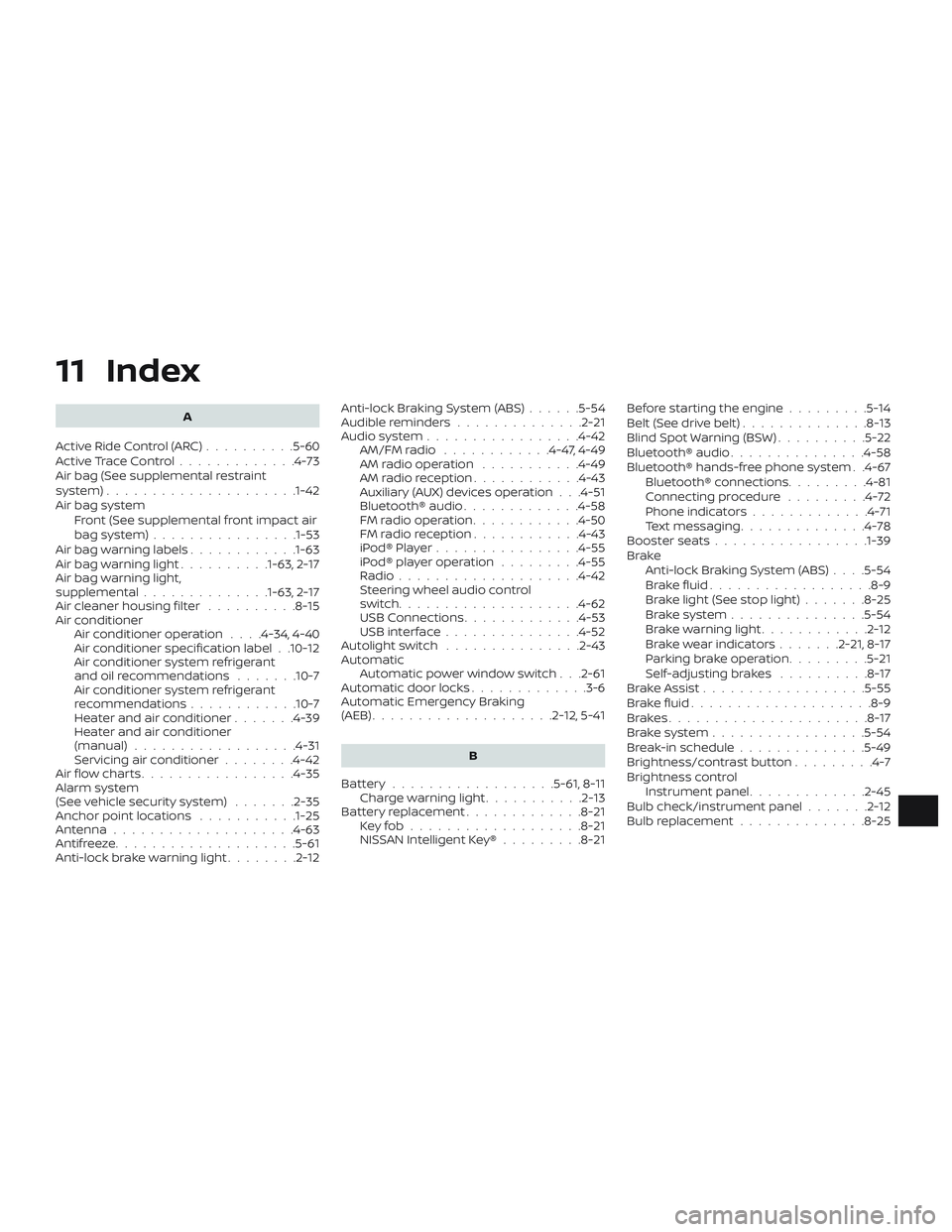
11 Index
A
ActiveRideControl(ARC)..........5-60
ActiveTraceControl.............4-73
Air bag (See supplemental restraint
system) .................... .1-42
Air bag system Front (See supplemental front impact air
bagsystem)............... .1-53
Air bag warning labels ............1-63
Airbagwarninglight..........1-63, 2-17
Air bag warning light,
supplemental ..............1-63, 2-17
Air cleaner housing filter ..........8-15
Air conditioner Air conditioner operation ....4-34,4-40
Air conditioner specification label . .10-12
Air conditioner system refrigerant
and oil recommendations .......10-7
Air conditioner system refrigerant
recommendations ............10-7
Heater and air conditioner .......4-39
Heater and air conditioner
(manual) ..................4-31
Servicing air conditioner ........4-42
Air flow charts .................4-35
Alarm system
(See vehicle security system) .......2-35
Anchor point locations ...........1-25
Antenna ....................4-63
Antifreeze ....................5-61
Anti-lock brake warning light ........2-12Anti-lock Braking System (ABS)
......5-54
Audible reminders ..............2-21
Audiosystem.................4-42 AM/FMradio ............4-47,4-49
AM radio operation ...........4-49
AMradioreception............4-43
Auxiliary (AUX) devices operation . . .4-51
Bluetooth® audio .............4-58
FM radio operation ............4-50
FMradioreception............4-43
iPod®Player................4-55
iPod® player operation .........4-55
Radio ....................4-42
Steering wheel audio control
switch....................4-62
USB Connections .............4-53
USBinterface...............4-52
Autolightswitch ...............2-43
Automatic Automatic power window switch . . .2-61
Automatic door locks .............3-6
Automatic Emergency Braking
(AEB) ....................2-12,5-41
B
Battery..................5-61,8-11 Charge warning light ...........2-13
Battery replacement .............8-21
Keyfob...................8-21
NISSAN Intelligent Key® .........8-21Before starting the engine
.........5-14
Belt(Seedrivebelt)..............8-13
Blind Spot Warning (BSW) ..........5-22
Bluetooth® audio ...............4-58
Bluetooth® hands-free phone system . .4-67 Bluetooth® connections .........4-81
Connecting procedure .........4-72
Phone indicators .............4-71
Text messaging ..............4-78
Booster seats .................1-39
Brake Anti-lock Braking System (ABS) ....5-54
Brakefluid..................8-9
Brakelight(Seestoplight).......8-25
Brakesystem...............5-54
Brakewarninglight............2-12
Brakewearindicators.......2-21,8-17
Parking brake operation .........5-21
Self-adjustingbrakes ..........8-17
Brake Assist ..................5-55
B
rakefluid....................8-9
Brakes......................8-17
Brakesystem.................5-54
Break-in schedule ..............5-49
Brightness/contrast button .........4-7
Brightness control Instrument panel .............2-45
Bulb check/instrument panel .......2-12
Bulb replacement ..............8-25
Page 430 of 444
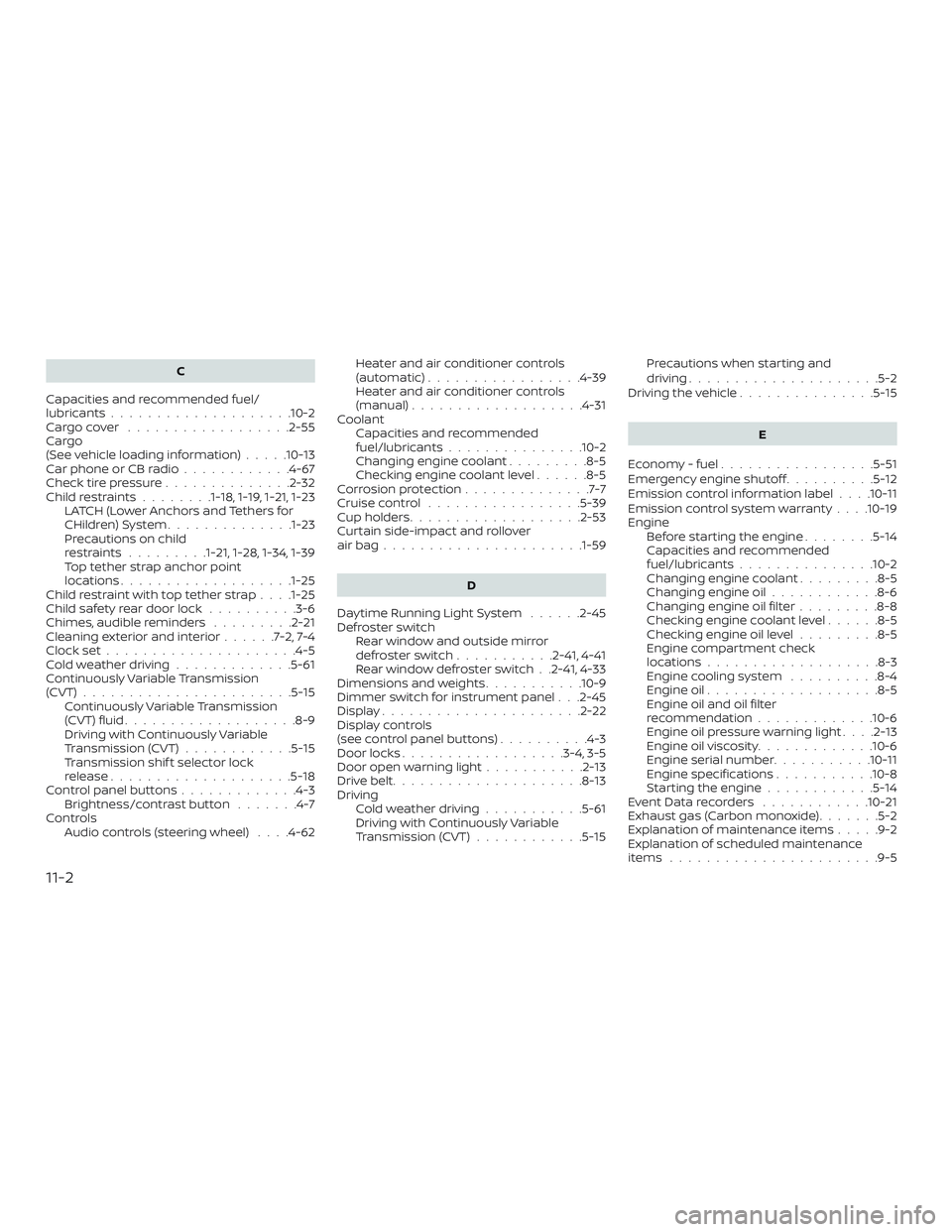
C
Capacities and recommended fuel/
lubricants....................10-2
Cargocover ..................2-55
Cargo
(See vehicle loading information) .....10-13
Car phone or CB radio ............4-67
Check tire pressure ..............2-32
Childrestraints........1-18, 1-19, 1-21, 1-23 LATCH (Lower Anchors and Tethers for
CHildren)System............. .1-23
Precautions on child
restraints.........1-21, 1-28, 1-34, 1-39
Top tether strap anchor point
locations.................. .1-25
Child restraint with top tether strap . . . .1-25
Child safety rear door lock ..........3-6
Chimes, audible reminders .........2-21
Cleaningexteriorandinterior......7-2,7-4
Clockset.....................4-5
Coldweatherdriving.............5-61
Continuously Variable Transmission
(CVT) .......................5-15
Continuously Variable Transmission
(CVT) fluid ...................8-9
Driving with Continuously Variable
Transmission (CVT) ............5-15
Transmission shif t selector lock
release....................5-18
Control panel buttons .............4-3
Brightness/contrast button .......4-7
Controls Audio controls (steering wheel) ....4-62Heater and air conditioner controls
(automatic).................4-39
Heater and air conditioner controls
(manual)
...................4-31
Coolant Capacities and recommended
fuel/lubricants...............10-2
Changing engine coolant .........8-5
Checking engine coolant level ......8-5
Corrosionprotection..............7-7
Cruisecontrol .................5-39
Cupholders...................2-53
Curtain side-impact and rollover
airbag..................... .1-59
D
Daytime Running Light System ......2-45
Defroster switch Rear window and outside mirror
defrosterswitch...........2-41,4-41
Rear window defroster switch . .2-41, 4-33
Dimensions and weights ...........10-9
Dimmer switch for instrument panel . . .2-45
Display......................2-22
Display controls
(see control panel buttons) ..........4-3
Door locks ..................3-4,3-5
Door open warning light ...........2-13
Drivebelt.....................8-13
Driving Cold weather driving ...........5-61
Driving with Continuously Variable
Transmission (CVT) ............5-15 Precautions when starting and
driving
.....................5-2
Driving the vehicle ...............5-15
E
Economy - fuel .................5-51
Emergency engine shutoff ..........5-12
Emission control information label . . . .10-11
Emission control system warranty . . . .10-19
Engine Before starting the engine ........5-14
Capacities and recommended
fuel/lubricants...............10-2
Changing engine coolant .........8-5
Changing engine oil ............8-6
Changing engine oil filter .........8-8
Checking engine coolant level ......8-5
Checking engine oil level .........8-5
Engine compartment check
locations...................8-3
Engine cooling system ..........8-4
Engine oil ...................8-5
Engine oil and oil filter
recommendation .............10-6
Engine oil pressure warning light ....2-13
Engine oil viscosity .............
10-6
Engine serial number ...........10-11
Engine specifications ...........10-8
Starting the engine ............5-14
EventDatarecorders ............10-21
Exhaust gas (Carbon monoxide) .......5-2
Explanation of maintenance items .....9-2
Explanation of scheduled maintenance
items .......................9-5
11-2
Page 433 of 444
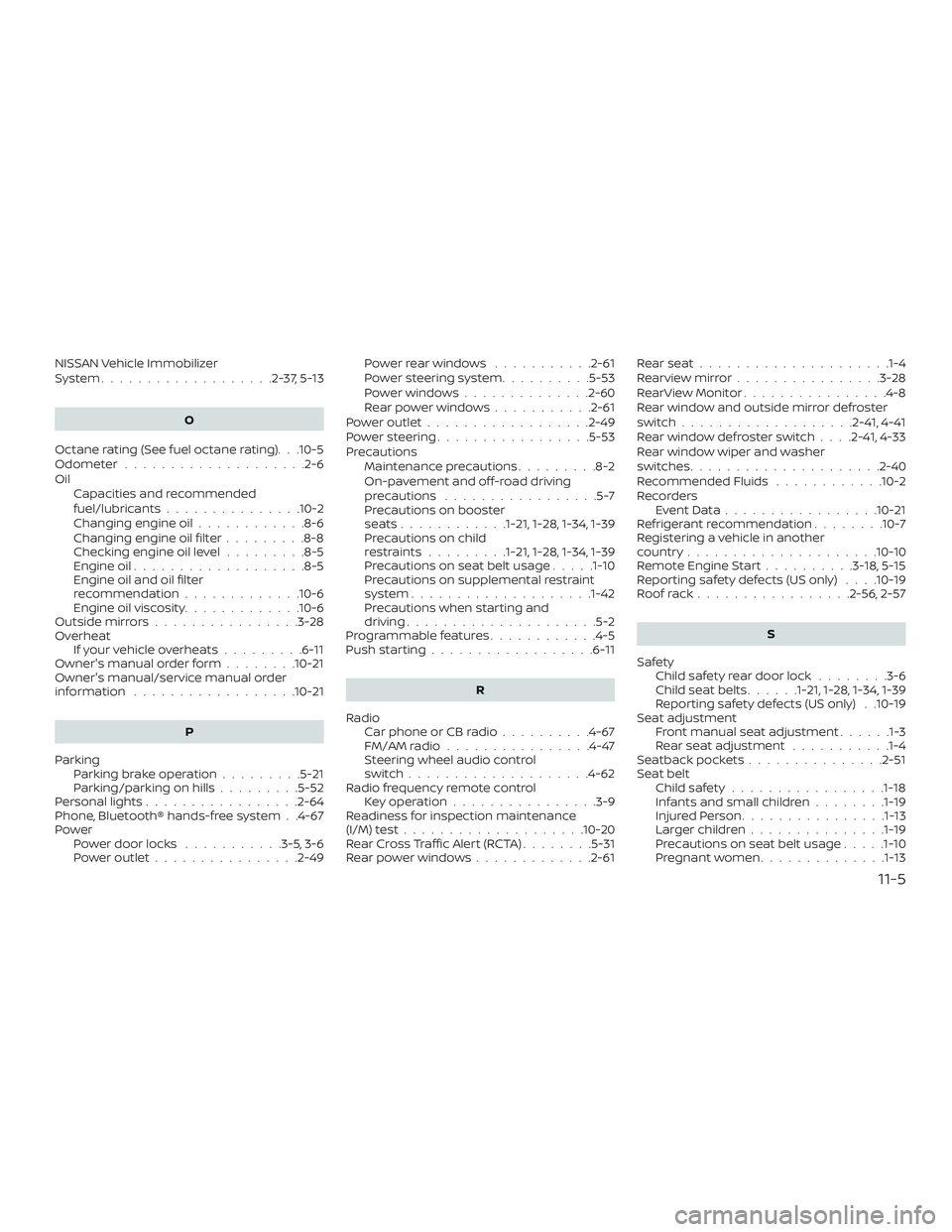
NISSAN Vehicle Immobilizer
System...................2-37,5-13O
Octane rating (See fuel octane rating). . .10-5
Odometer ....................2-6
Oil Capacities and recommended
fuel/lubricants...............10-2
Changing engine oil ............8-6
Changing engine oil filter .........8-8
Checking engine oil level .........8-5
Engine oil ...................8-5
Engine oil and oil filter
recommendation .............10-6
Engine oil viscosity .............10-6
Outsidemirrors................3-28
Overheat Ifyourvehicleoverheats.........6-11
Owner's manual order form ........10-21
Owner's manual/service manual order
information ..................10-21
P
Parking Parking brake operation .........5-21
Parking/parkingonhills.........5-52
Personal lights .................2-64
Phone, Bluetooth® hands-free system . .4-67
Power Power door locks ...........3-5,3-6
Poweroutlet................2-49 Powerrearwindows ...........2-61
Power steering system
..........5-53
Powerwindows..............2-60
Rearpowerwindows...........2-61
Poweroutlet..................2-49
Powersteering.................5-53
Precautions Maintenance precautions .........8-2
On-pavement and off-road driving
precautions .................5-7
Precautions on booster
seats............1-21, 1-28, 1-34, 1-39
Precautions on child
restraints.........1-21, 1-28, 1-34, 1-39
Precautions on seat belt usage .....1-10
Precautions on supplemental restraint
system ................... .1-42
Precautions when starting and
driving.....................5-2
Programmable features ............4-5
Push starting ..................6-11
R
Radio Car phone or CB radio ..........4-67
FM/AMradio................4-47
Steering wheel audio control
switch....................4-62
Radio frequency remote control Key operation ................3-9
Readiness for inspection maintenance
(I/M) test ....................10-20
RearCrossTrafficAlert(RCTA)........5-31
Rearpowerwindows.............2-61 Rearseat.....................1-4
Rearviewmirror................3-28
RearViewMonitor................4-8
Rear window and outside mirror defroster
switch...................2-41,4-41
Rear window defroster switch . . . .2-41, 4-33
Rear window wiper and washer
switches
.....................2-40
Recommended Fluids ............10-2
Recorders EventData.................10-21
Refrigerant recommendation ........10-7
Registering a vehicle in another
country .....................10-10
Remote Engine Start ..........3-18,5-15
Reporting safety defects (US only) . . . .10-19
Roofrack.................2-56,2-57
S
Safety Child safety rear door lock ........3-6
Childseatbelts......1-21, 1-28, 1-34, 1-39
Reporting safety defects (US only) . .10-19
Seat adjustment Front manual seat adjustment ......1-3
Rear seat adjustment ...........1-4
Seatback pockets ...............2-51
Seat belt C
hildsafety................ .1-18
Infants and small children ........1-19
InjuredPerson............... .1-13
Largerchildren.............. .1-19
Precautionsonseatbeltusage.....1-10
Pregnant women ..............1-13
11-5
Page 434 of 444
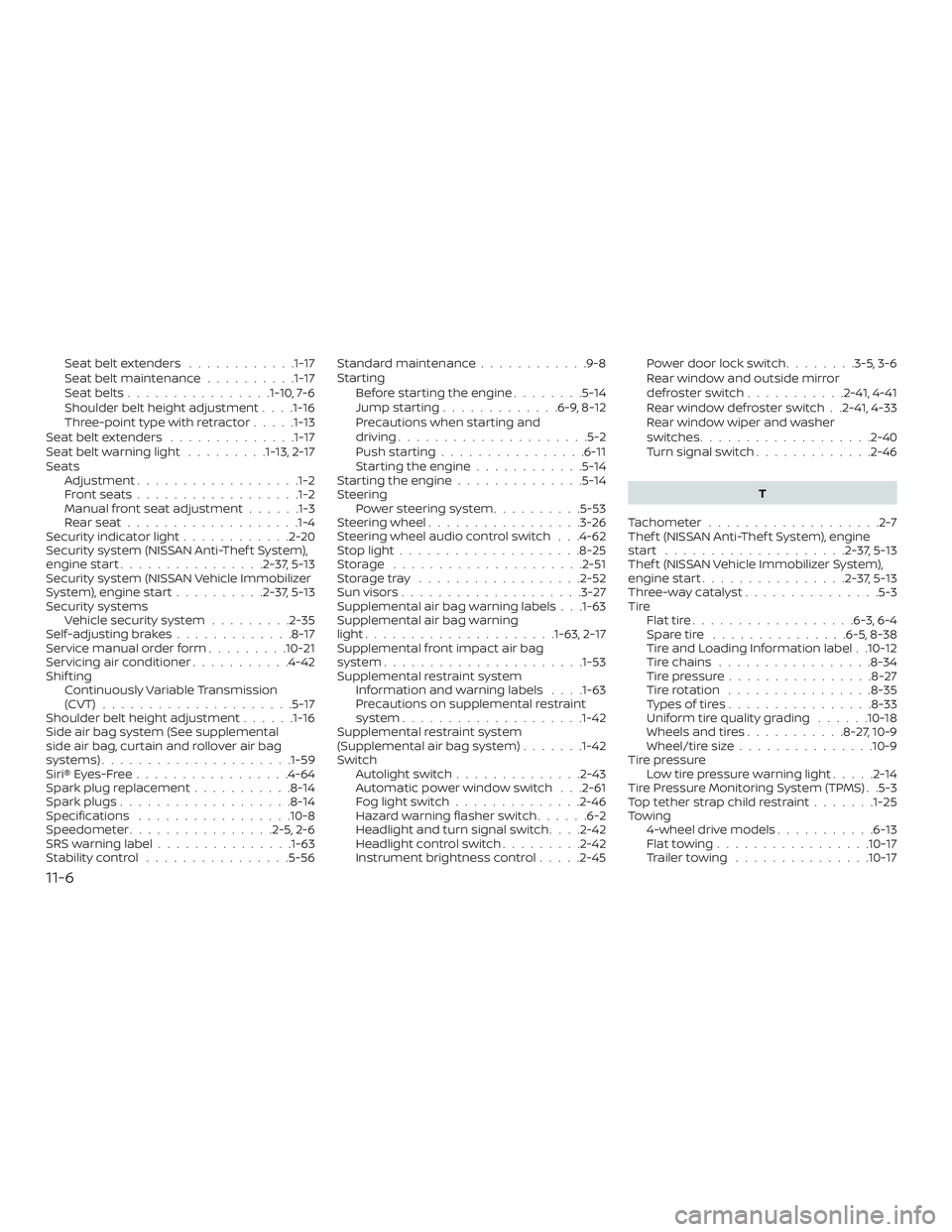
Seat belt extenders............1-17
Seat belt maintenance ..........1-17
Seatbelts................1-10, 7-6
Shoulder belt height adjustment . . . .1-16
Three-pointtypewithretractor.....1-13
Seat belt extenders ..............1-17
Seatbeltwarninglight .........1-13, 2-17
Seats Adjustment ..................1-2
Frontseats..................1-2
Manual front seat adjustment ......1-3
Rearseat.................. .1-4
Security indicator light ............2-20
Security system (NISSAN Anti-Thef t System),
engine start ................2-37,5-13
Security system (NISSAN Vehicle Immobilizer
System), engine start ..........2-37,5-13
Security systems Vehicle security system .........2-35
Self-adjustingbrakes.............8-17
Service manual order form .........10-21
Servicing air conditioner ...........4-42
Shif ting Continuously Variable Transmission
(CVT) .....................5-17
Shoulder belt height adjustment ......1-16
Side air bag system (See supplemental
side air bag, curtain and rollover air bag
systems) .................... .1-59
Siri® Eyes-Free .................4-64
Spark plug replacement ...........8-14
Spark plugs ...................8-14
Specifications .................10-8
Speedometer ................2-5,2-6
SRS warning label ...............1-63
Stability control ................5-56 Standard maintenance
............9-8
Starting Before starting the engine ........5-14
Jumpstarting.............6-9,8-12
Precautions when starting and
driving.....................5-2
Push starting ................6-11
Starting the engine ............5-14
Starting the engine ..............5-14
Steering Powersteeringsystem..........5-53
Steering wheel .................3-26
Steering wheel audio control switch . . .4-62
Stoplight....................8-25
Storage .....................2-51
Storagetray ..................2-52
Sunvisors....................3-27
Supplemental air bag warning labels . . .1-63
Supplemental air bag warning
light.................... .1-63, 2-17
Supplemental front impact air bag
system ..................... .1-53
Supplemental restraint system Information and warning labels . . . .1-63
Precautions on supplemental restraint
system ................... .1-42
Supplemental restraint system
(Supplemental air bag system) .......1-42
Switch Autolightswitch..............2-43
Automatic power window switch . . .2-61
Foglightswitch..............2-46
Hazard warning flasher switch ......6-2
Headlight and turn signal switch ....2-42
Headlightcontrolswitch.........2-42
Instrument brightness control .....2-45Power door lock switch
........3-5 , 3-6
Rear window and outside mirror
defrosterswitch...........2-41,4-41
Rear window defroster switch . .2-41, 4-33
Rear window wiper and washer
switches ...................2-40
Turn signal switch .............2-46
T
Tachometer ...................2-7
Thef t (NISSAN Anti-Thef t System), engine
start ....................2-37,5-13
Thef t (NISSAN Vehicle Immobilizer System),
engine start ................2-37,5-13
Three-waycatalyst...............5-3
Tire Flattire..................6-3,6-4
Spare tire ...............6-5,8-38
Tire and Loading Information label . .10-12
Tire chains .................8-34
Tire pressure ................8-27
Tirerotation ................8-35
Types of tires ................8-33
Uniform tire quality grading ......10-18
Wheels and tires ...........8-27,10-9
Wheel/tire size ...............10-9
Tire pressure Low tire pressure warning light .....2-14
Tire Pressure Monitoring System (TPMS) . .5-3
Toptetherstrapchildrestraint.......1-25
Towing 4-wheel drive models ...........6-13
Flattowing.................10-17
Trailertowing ...............10-17
11-6